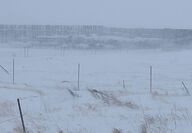Sorted by date Results 1 - 5 of 5

April blizzards may bring May flowers, but blizzards can also cause newborn calves and other livestock to become smothered, trampled and die due to the conditions created by adverse weather. These death losses can create an emotional and financial burden for livestock producers. North Dakota State University (NDSU) Extension specialists encourage ranchers to inquire about the Livestock Indemnity Program provided by the U.S. Department of Agriculture (USDA) Farm Service Agency (FSA). "The...

Following a cooler-than-normal spring 2022 and the 2021 drought, ranchers should expect a delay in grass development and growth this spring. "Air temperature is the main environmental factor that determines the rate of grass development," says Miranda Meehan, North Dakota State University Extension livestock environmental stewardship specialist. "Each leaf produced on a stem requires a specific amount of accumulated heat, or heat units. The temperature when plants initiate development, or the...
Abortions can be a major concern for cattle producers. An “abortion” is the discharge of the fetus prior to the end of the normal gestation period, according to Gerald Stokka, North Dakota State University Extension Service veterinarian and livestock stewardship specialist. Many abortions occur in the first 45 days of conception (called early embryonic death), and the embryos or fetuses are so small that they may not be seen. Other abortions may occur near normal calving time, and determining whether the cow has aborted or given birth premature...

Only 7 percent of soil samples show a moderate to high risk for wheat midge infestation. Soil samples in North Dakota indicate decreased levels of overwintering wheat midge larvae (cocoons) for the 2015 season, according to Janet Knodel, North Dakota State University Extension Service entomologist. A total of 196 soil samples were collected from 21 counties in the fall of 2014 to estimate the regional risk for wheat midge. The distribution of wheat midge in 2015 is based on unparasitized...
Canola can be an alternative feed for livestock, but producers need to be aware of the challenges. Drought-challenged dairy producers facing forage shortages may be able to feed their cows canola and related crops, provided they take certain precautions. “Recent rains were spotty, and encroaching drought in North Dakota has livestock producers scrambling for much-needed forage,” says J.W. Schroeder, North Dakota State University Extension Service dairy specialist. “Dairy managers are particularly concerned about feed shortages because they...